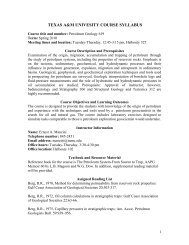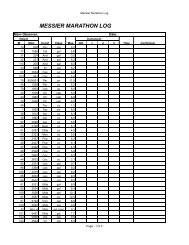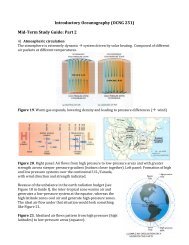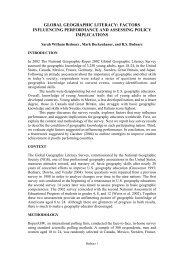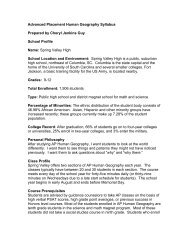Linking Early U.S. History to World Geography Module 1, Activity 1 ...
Linking Early U.S. History to World Geography Module 1, Activity 1 ...
Linking Early U.S. History to World Geography Module 1, Activity 1 ...
You also want an ePaper? Increase the reach of your titles
YUMPU automatically turns print PDFs into web optimized ePapers that Google loves.
<strong>Linking</strong> <strong>Early</strong> U.S. <strong>His<strong>to</strong>ry</strong> <strong>to</strong> <strong>World</strong> <strong>Geography</strong><br />
Events of the 1861-1865 (cards61-65.pdf), cut in<strong>to</strong> strips, one set per group of students<br />
Student Work Log, one per student<br />
Blank outline maps of the Thirteen Colonies, one for each student<br />
Blank outline maps of the United States, one for each student<br />
Sample s<strong>to</strong>ry maps on overhead transparencies (optional)<br />
Master Lists: Events of 1775-1776 (master75-76.pdf), Events of 1785-1788 (master85-88.pdf),<br />
and Events of 1861-1865 (master61-65.pdf) for teacher reference<br />
Content Preview<br />
Depending upon the time period you wish <strong>to</strong> work with, introduce the activity <strong>to</strong> students in the<br />
context of learning about his<strong>to</strong>rical events from a geographic perspective. Students should<br />
understand these three statements:<br />
• It is impossible <strong>to</strong> understand the present without understanding geography.<br />
• It is impossible <strong>to</strong> understand the present without understanding the past.<br />
• It is impossible <strong>to</strong> understand the past without understanding geography.<br />
In other words, the rationale for his<strong>to</strong>ry (studying the past <strong>to</strong> understand the present) requires<br />
knowing geography: <strong>to</strong>day’s geography and the geography of places in the past. This activity focuses<br />
on location but other activities in this series include details related <strong>to</strong> human and environmental<br />
characteristics of locations, human-environmental relations and spatial organization, all of which play<br />
a role in understanding the geography of the past.<br />
A s<strong>to</strong>ry map is a special kind of map; a blend between a map and a s<strong>to</strong>ry. Key events are put in<strong>to</strong><br />
spatial context, with annotations (labels, brief statements) and graphics (arrows, dotted lines,<br />
symbols) that provide narration. Three examples of s<strong>to</strong>ry maps are included in this activity. Each is<br />
different but all tell a s<strong>to</strong>ry through a map. You may wish <strong>to</strong> make transparencies of these <strong>to</strong> show<br />
students as they develop their own.<br />
Classroom Procedures<br />
Beginning the <strong>Activity</strong><br />
1. Distribute the appropriate timeline cards, one set each <strong>to</strong> a small group of students and Student<br />
Work Logs. If you prefer students may work individually throughout the activity but <strong>to</strong> begin small<br />
groups (two or three students) makes sense.<br />
2. Ask students <strong>to</strong> do two things with the cards: A. read each card and make sure they understand<br />
all terms and concepts; B. put the cards in<strong>to</strong> chronological order. You may wish <strong>to</strong> refer <strong>to</strong> the<br />
master lists as students review events.<br />
3. Have students briefly review the sequence of events by asking questions like “What happened<br />
first? Then what happened?” You may wish <strong>to</strong> ask students <strong>to</strong> write a brief summary on their Log.<br />
Developing the <strong>Activity</strong><br />
4. Next, ask students <strong>to</strong> sort the cards by location. Once again, review the sequence of events, this<br />
time asking questions like “Where did that take place? Why do you think this happened there? Can<br />
2




